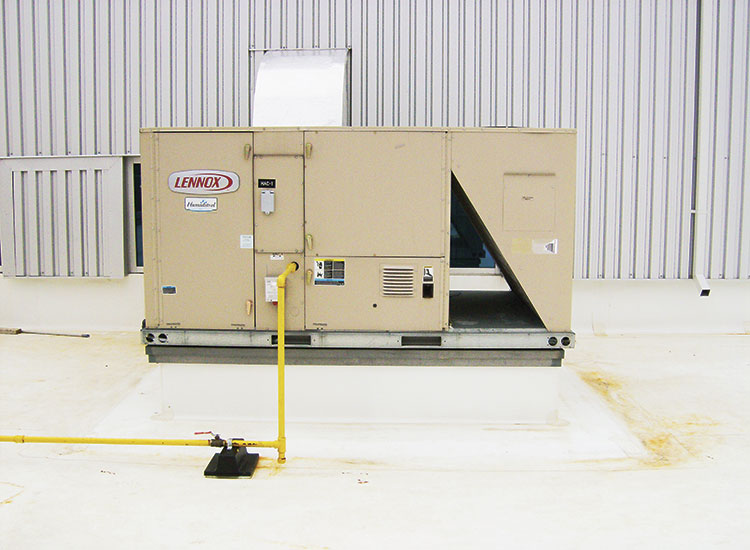"Using Lennox' ERS units were key to achieving the required energy-use reduction credit for LEED certification."
-Martin Caracciolo
Customer
PowerStream Inc., one of Ontario’s largest local electricity distributors
Issue
Three Canadian power companies merged in 2004 to create PowerStream Inc.; two years later, PowerStream purchased Aurora Hydro, closed that company’s head office and moved the employees to its own already cramped and overworked facilities in Markham and Vaughan, Ontario. The electricity distributor decided to create a single building that would combine its multiple facilities into one, including a large IT department and a 24/7 control room used to monitor the region’s power grid. Energy efficiency and HVAC reliability were paramount in the construction of the new 92,000-sq.-ft. facility.
As a leading proponent of conservation and sustainability, PowerStream wanted to reduce its own environmental footprint and set an example for other businesses constructing new facilities. The power distributor chose to incorporate LEED® (Leadership in Energy and Environmental Design) program features into its new headquarters with the goal of becoming the first LEED Gold certified building in York Region, Ontario. The building’s design includes sustainable features designed to save 330,000 kilowatt hours annually, enough electricity to power 48 average-sized homes for one year.
Solutions
As heating and cooling can account for up to 40% of the average commercial building’s energy bill,* installing an energy-efficient HVAC system was key to minimizing the energy needs of the PowerStream headquarters and helping qualify for LEED credits. Engineer Martin Caracciolo of GMC Engineering worked with several green building sources to develop a variety of sustainable solutions for the PowerStream building, including Enermodal Engineering, one of Canada’s premier green building consultants; Lennox Industries, the only HVAC manufacturer ever selected as an ENERGY STAR® Manufacturing Partner of the Year by the U.S. Environmental Protection Agency (EPA) and U.S. Department of Energy; and Brusan Heating & Air Conditioning Ltd., a distinguished commercial building contractor in Ontario.
First, the designers chose an underfloor air distribution (UFAD) system for the facility, an advanced construction technique that can increase occupant comfort by improving direct control of supply airflow to reduce uncomfortable stratification and improve indoor air quality. The UFAD design, however, created several challenges for the HVAC system.
“While packaged rooftop units are an unusual choice for UFAD systems, we got the necessary support from Lennox to assure us that the conditions could be met,” explains Martin Caracciolo.
“Denis Delisle of Lennox provided load calculations that verified the equipment would provide the higher supply air temperatures while still satisfying our overall cooling requirements.”
In addition to high-efficiency boilers with variable-speed pumps, several high-efficiency L Series® rooftop units with capacities ranging from 7.5 to 25 tons were installed to help PowerStream control its energy usage. “We chose L Series units for their high performance and for their exceptional efficiency ratings,” explains Victor Tesan of Brusan Heating Air Conditioning. L Series units are available with ratings as high as 13.25 SEER, 12.2 EER and 14.7 IPLV. Their variable-air-volume design allows different amounts of cooling to be provided to most areas served by the underfloor air distribution system, as a result of the variable volume control of the floor diffusers (either manual or automatic). The non-variable air volume L Series units feature the original Humiditrol® dehumidification system with a patented hot gas reheat design that controls humidity independently of the thermostat to reduce expensive and uncomfortable overcooling.
To help reduce energy costs even further, Martin incorporated Energy Recovery Systems (ERSs) with variable frequency drives; these systems use recycled energy to condition air before it enters the building, improving the HVAC system’s efficiency and helping improve the building’s indoor air quality. ERSs can be tied into duct systems in a variety of locations. “While most buildings similar to this one incorporate either customized units or built-up equipment to provide the conditions required, we chose Lennox’ L Series VAV units because of their ease of use and because they have been proven to perform well in a wide range of applications,” says Martin Caracciolo
-Martin Caracciolo

Results/Benefits
“Using Lennox’ ERSs were key to achieving the required energy-use reduction credit for LEED certification,” explains Martin. “The ERSs were able to provide variable-speed capabilities, and its wheel can be tilted out of the way in economizer mode.” The ERS units selected were chosen to meet ASHRAE 62-2004 minimum outside air requirements; the units are able to supply 100% outside air through the economizer. The ERSs, in conjunction with the L Series units, helped achieve 4 points in the EAc1 credit. Rooftop units featuring the environmentally friendlier refrigerant R-410A (to reduce chlorine-containing compounds) were used to help achieve 1 point of EAc4 credit under the LEED program.
* U.S. DOE Energy Information Administration; ”Impacts of Temperature Variation on Energy Demand in Buildings”